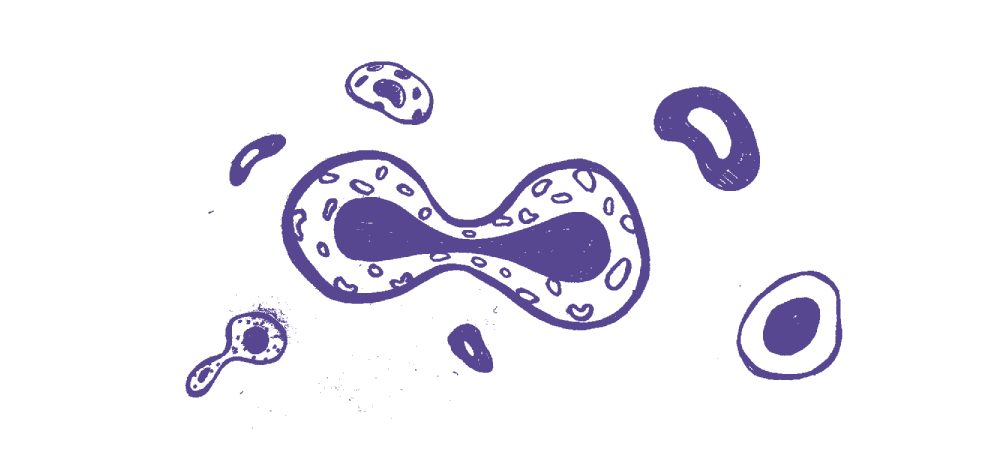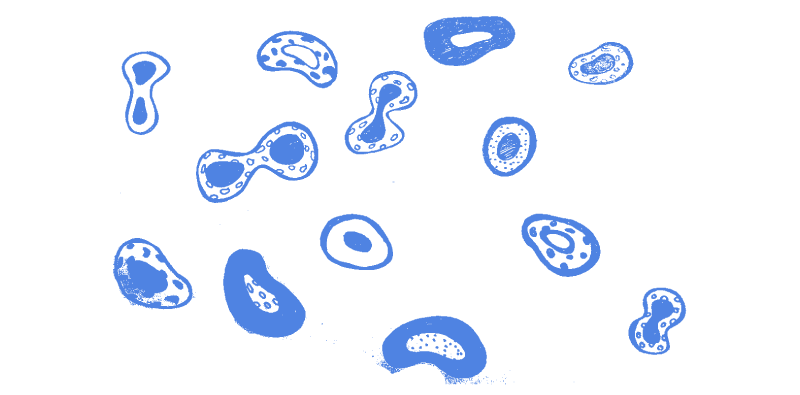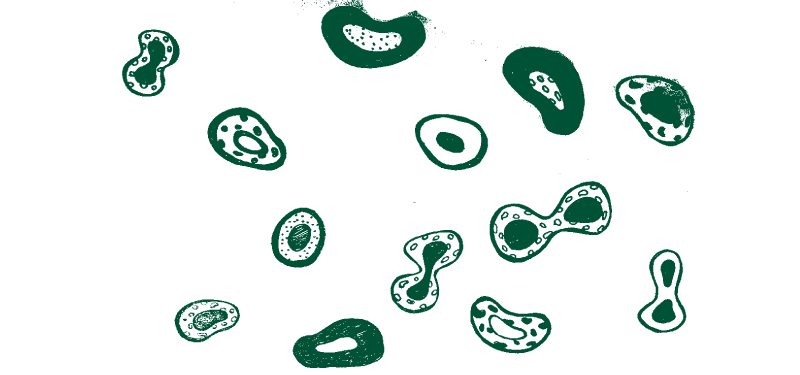Arvind Dilawar: How did you first start working with tissue engineering as an art form?
Oron Catts: My background is in product design and visual arts, so I’m not a scientist. My interest stems from the fact that, more than 20 years ago, I realized that biology was becoming engineering and life was becoming the raw material to be engineered, so I wrote my design thesis in what can now be called a “speculative design” kind of approach, looking at the potential future in which design and biotech might come together. Once engineers are moving into biology, they will start to develop products, and designers would have to come in to design those products. I find it both fascinating and exciting, but also extremely problematic and challenging. I decided to continue my investigation as an artist because I felt that, as an artist, I’m much more capable of problematizing the issues, rather than trying to solve or be perceived as if I’m solving any problems. I think there’s so many problems still left to be highlighted. I became a problem-seeker rather than a problem-solver.
I suppose tissue engineering in particular was interesting for me for two main reasons: One, I was extremely taken by the image of the mouse with the human ear on its back and its first public appearance in 1995. As I was investigating my approach to designer biotechnology, this image came about. It generated a perception that bodies are now so malleable that we can sculpt with living biological material and living biological bodies.
Second, the theoretical product that I was developing for my design thesis was a custom grown living surface. I was looking at growing living surfaces of different origins, looking at things like cellulose. But at the time, tissue engineering just started to develop skin for burn patients. It was the first FDA-approved tissue-engineering product. The idea of skin, the idea of fragmenting complex bodies and growing parts of them in artificial environments became very interesting. I found that’s got a much more interesting potential to highlight some of the problems that I started to identify.
AD: Do you consider yourself a critic of tissue engineering?
OC: I exercise a critical thinking and reflexive approach in a field where there’s not enough of it. We live in a time where quite a lot of what’s going on, especially within technological development, is being glossed over in the sense that we’re being sold the perceived benefits, which are sometimes total fabrications, and there’s very little time to have conversations around some of the other ethical issues that have to do with our relationship to bodies.
I’ve been labeled a religious fanatic, although I’m not of any religious persuasion of any sort. I’ve been labeled a Luddite, but at the very same time I’ve been also developing new approaches to life that are now being used by the very same people that I’m critiquing.
As an artist, I have to be fairly ambiguous. I’m not really interested in developing either a dystopian or an overly utopian idea of where those technologies are going to take us. I just want to point out areas where I feel we need much more attention. I can be seen sometimes as being critical of it, but what I would like to position myself as is actually someone who’s pointing out where things are problematic.
AD: What are the problem areas?
OC: My approach that I developed over the last 20 years, which seems to be followed by many other people — a growing number of people in the last few years in particular — is this idea of direct engagement with living biological material. As an artist, I’m not interested in just looking over someone’s shoulder or imagining those fantastic scenarios; I’m interested in working with the materiality of the technology, and I’m trying to find the cutting-edge technology, where things are the most advanced, then see where that goes.
But saying that, I’m becoming much more interested in the mindsets that drive those technological approaches. In a wide range of biological interventions, from synthetic biology through tissue engineering and all the way up to neuroengineering, what I find really problematic is what I refer to as “the illusion of control.” A lot of what’s happening within biology at the moment, especially in synthetic biology, is driven by the engineering mindset of control. The idea is that if we have some kind of understanding of how our biological system operates, we will be able to control the outcomes in a predictable way.
Time and time again, biology comes back to bite us. Biology doesn’t work like that. Living biological systems are, by definition, not that ruly. They are unruly and are really hard to scale up or to impose our engineering mindsets over. A lot of the promises of contemporary biological technologies are not going to be fulfilled just because, basically, it’s like having a new industry based on physics but forgetting that gravity exists, imagining that you can develop technologies without considering gravity as a constraint. A lot of what I see coming out of the promises of especially synthetic biology and a lot of other contemporary biological approaches is disregarding many of the core issues that lie at the bottom of what biology is.
If you want to be more critical about it, there are two things that could come out of this: One is that, in the not so far future, we hit our heads against those biological impossibilities, and like previous cycles of biotech, there will be a bust. The bubble would deflate or even explode, and the trust in those technologies, some of which have potential, would be lost. It’s a missed opportunity in the sense that there’s so much hype and vapor around biotechnology at the moment that once the reality will hit, it will hit across the board. The second thing is obviously this mindset of control. If there’s anything that we learn from history, it’s that what we choose to do to other living biological systems, we end up doing to ourselves. Neuro-enhancement, for example: If you have a ruling class starting to operate as if they can have control over neural processors, you can imagine that the outcomes might not be very delightful.
AD: What do you see bursting the biotech bubble?
OC: Now, more than any other time in history, there are huge financial resources that are being thrown onto those new approaches to biotechnology and especially this idea of biotechnology for consumer products. It can be traced back to Silicon Valley. The affluent class in Silicon Valley has reached an age where they start to realize that they have living biological bodies that they have to tend to in some way or another. They are quite impatient in the sense that they’re not really interested in investing in biomedical products because the turnaround of that is really long. From development to commercialization, because of all of the regulatory issues in bringing medical devices and pharmaceuticals to market, it’s around 20 years. They’re trying to short circuit that by investing in companies that don’t need to go through those processes. That’s why you see the birth of those new biotech companies which position themselves as biotech for consumer products. This is the whole in vitro meat, leather, cosmetics — all of those areas where they feel they can push biotechnological research without that many constraints.
In order for that to happen, you have both the people who are in the field who are trying to attract venture capitalists, so they promise a lot and they promise really large-scale outcomes, and you have quite a lot of charlatans coming into the market. You have really funny new companies which, for everyone who’s got a basic understanding of biological processes, you know that those people promise things that are not possible, basically “gravity-less” products — physics without gravity, so biology without constraints. Those people are getting heaps of money because the narrative is so seductive.
This is something that I’ve found, which surprisingly I’m sharing with quite a lot of biologists: the concern around the current approach, which is trying to industrialize biological systems — the industrialization of biology — while the opposite might be a much better approach, and that’s the biologization of industry.
AD: Can you give examples of each of those?
OC: The industrialization of biology is looking at cells as factories and trying to impose the current modes of production and distribution onto living biological systems. You basically require those biological systems to be upscaled, to be efficient, to be standardized. You want to make those standardized biological parts that you want to put together. You have those circuits and you have the outcomes. It’s all very rationalist and standardized, yields results and it’s upscalable. The main thing is that you can upscale it to a huge industrial scale.
Biological systems and organisms are not really well adapted to that kind of upscaling, especially when you think about the fact that in order to upscale those types of biological production, you have to have an environment which is very conducive to life. You want the lifeform that you engineered to produce something, you want it to thrive. But by doing so, you create conditions for other lifeforms to also come in. The only solution for that is either creating situations where you need to maintain everything in hyper-sterile conditions, and those are expensive and are really problematic when you try to upscale it to commercial or industrialized scales, or you try to develop environments which are extremely toxic for anything besides the lifeform that you’re trying to grow. There you have issues with all of the rhetoric around biological systems being environmentally friendly ways of production. Suddenly you have to create toxic environments to maintain the only life form that you have. There’s a flaw in the logic there.
The biologization of industry is a much more artisan approach. If you do it on a smaller scale and you do those boutique-type products, you might find yourself in a better situation, where it’s really like small-scale farming as opposed to industrialized farms. So there’s potential there. But the problem is that in order to attract the kind of money that those companies are looking for, in order to seduce venture capitalists, you tend to talk about things like growing in vitro meat for McDonald’s rather than growing in vitro meat for [British celebrity chef] Heston Blumenthal.
That’s going to be one of the main mistakes of the field: promising too much and losing the public trust by doing so. If someone tells me they’re growing meat for McDonald’s, I know that I can’t really trust that person to have my interests in the forefront of their operation. While if someone says, “I’m going to do a piece of luxury meat,” that’s OK. You might be supporting the one percent, but in a sense, the one percent then becomes your guinea pig as well.
AD: Are there other examples of “gravity-less” products?
OC: In vitro meat is one of them. Leather is kind of an interesting case. I think the companies that are working now realize that the only avenue they can take at the moment is a luxury product, something special. Because leather is basically a byproduct, it will be really hard to compete with.
AD: Are the techniques used to engineer tissue leather vastly different from meat?
OC: Not really. The basic techniques of tissue culture have been developed more than a hundred years ago, and in a sense, we’re still using very similar techniques. It’s just trying to figure out different things, like the substrate in which you grow it. If you want to grow leather, you obviously want to get cells that deposit collagen, and then the collagen would have the structural integrity similar to leather or better.
With muscle cells you need to — and this is what my understanding is that [Dutch professor and in vitro meat researcher] Mark Post is doing — you need to figure out ways to get the muscle cells to align and to exercise, which you won’t need to do to leather, but you might have to find other ways in which you apply other stress on the cells as they’re growing in order for them to deposit and align the collagen in order to have better quality of the leather that’s being produced. Again, it’s a technologically excessive way of doing things, which I have no issue with as long as they’re honest about the fact that it is, for the foreseeable future, going to be a luxury project, a technologically excessive kind of novelty luxury product.
At this stage, I would say a full, grown-up leather jacket would be in the tens, if not hundreds of thousands of dollars, if you need to include things like the labor involved, all of the nutrients, the infrastructure around it. I think what those companies face time and time again is the realization that it would be really, really hard for them to upscale those operations. It would still be small operations.
AD: Do you anticipate any progress on that front in the near future?
OC: I’ve been going to tissue engineering meetings for the better part of the last 20 years. It’s really interesting to see how the discourse changes when those scientists are with their peers, where a lot of the discussion is really about how much they don’t know, and then when they confront the public or the press and they have to take a posture of experts, where they give us a sense that they know everything and everything is under control and it’s just a matter of tweaking it a little bit and everything will be out there.
For the last 20 years, the technologies that allow research into tissue engineering has increased dramatically, things like automation and creating those environments in which you can grow cells and creating inscription devices, devices that help you measure the different aspects of biological activity. All of those areas are really progressing. It’s really amazing, each conference you go to, there’s a new toy to do those things.
But to a large extent, the fundamental biological issues and questions are almost identical to what they were 20 years ago. I have an archive of stories around developments in tissue engineering for the last 20 years, and the language is almost the same in regard to “We’re just about to grow an ear or a nose or heart or whatever, give us ten, 20 years and it will be OK.” It’s like those ten, 20 years just continue each time. And that’s because, again, there’s some major fundamental biological issues that tissue engineering can’t solve. And I don’t know if it will ever be solved. Maybe it’s a dead end and we’re barking up the wrong tree.
Because there’s all of those toys around, now they’re trying to figure out what they can use them for if the biomedical path is not going to yield the type of results they were hoping for. That’s another reason why, especially with tissue engineering, why we see approaches to using those technologies, using those toys to develop consumer products.
AD: Do you see it as the “plan B?”
OC: Yeah, to some extent it is the plan B. Some of the companies that have been involved in developing the technologies for tissue engineering are now kind of diversifying their portfolio. They have subsidiary companies that might be developing consumer products. This is also kind of the interesting thing where they’re starting to employ designers, so you start to see more and more companies that have creative directors or similar positions, which was unheard of in the context of biotechnology until very recently. But that was exactly what I was predicting 20 years ago, which is kind of interesting from my perspective.
What you’ll start to see, especially once those creative directors are moving in, you’ll see the diversification of the type of products, but you’ll also have the marketing ploy of how those things will be integrating in other products or standalone products. We’ll see much more of a discussion around it. We’ll see all of those novelty things coming out. I still don’t really see a way in which in vitro meat will be coming out on a mass scale, but what I would really like to see is in vitro meat coming into a molecular gastronomy restaurant near you. Those kind of approaches, actually, can open some really interesting conversations as well.
Tissue engineering, in the foreseeable future, it’s not going to be a huge market, but there are going to be some interesting little novelties coming out of it, which would hopefully also generate some interesting conversations around what it means to have animal products that have never been part of an animal. •
Graphics created by Emily Anderson.







